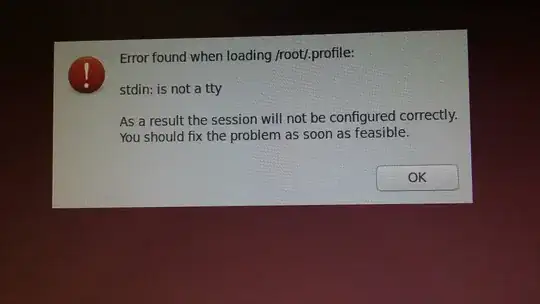I know from searching that this has come up multiple times in the last few years. However most of the solutions are simply to ensure the ownership of .Xautority is set properly and that 777 is set as the permissions for /tmp. In my case, neither of these are the issue; I checked. Another common cause I found was Nvidia vs. Nouveau graphics drivers. However, I have rebooted and used the computer several times since I last changed the graphics driver and did not have any issues.
The issues started after I allowed the AutoUpdate program to install some updates. It might be worth noting that these updates are a bit suspicious. It wanted to install them yesterday and I initially said no. Then I ran the updater manually and it said there were no updates. When it asked me again today, I said yes and it did its thing. It then asked me to reboot the computer which I did. That is when the trouble started. Below is the contents of the various .xsession-errors files.
User 1 Attempt 1
Script for ibus started at run_im.
Script for auto started at run_im.
Script for default started at run_im.
init: at-spi2-registryd main process ended, respawning
init: at-spi2-registryd main process ended, respawning
init: gnome-session (Unity) main process (2563) terminated with status 1
init: unity-settings-daemon main process (2537) killed by TERM signal
init: logrotate main process (2458) killed by TERM signal
init: update-notifier-crash (/var/crash/_usr_bin_nautilus.1000.crash) main process (2496) killed by TERM signal
init: update-notifier-release main process (2502) killed by TERM signal
init: xsession-init main process (2531) killed by TERM signal
init: hud main process (2550) killed by TERM signal
init: unity-panel-service main process (2576) killed by TERM signal
init: Disconnected from notified D-Bus bus
init: window-stack-bridge main process (2488) killed by KILL signal
User 1 Attempt 2
Script for ibus started at run_im.
Script for auto started at run_im.
Script for default started at run_im.
init: gnome-session (Unity) main process (2010) terminated with status 1
init: unity-settings-daemon main process (2002) killed by TERM signal
init: Disconnected from notified D-Bus bus
init: logrotate main process (1928) killed by TERM signal
init: window-stack-bridge main process (1959) killed by TERM signal
init: update-notifier-release main process (1978) killed by TERM signal
init: hud main process (2006) killed by TERM signal
init: indicator-bluetooth main process (2088) killed by TERM signal
init: indicator-power main process (2094) killed by TERM signal
init: indicator-datetime main process (2095) killed by TERM signal
init: indicator-sound main process (2098) killed by TERM signal
init: indicator-printers main process (2103) killed by TERM signal
init: indicator-session main process (2108) killed by TERM signal
init: indicator-application main process (2148) killed by TERM signal
User 2 Attempt 1
Script for ibus started at run_im.
Script for auto started at run_im.
Script for default started at run_im.
init: at-spi2-registryd main process ended, respawning
init: at-spi2-registryd main process ended, respawning
init: at-spi2-registryd main process ended, respawning
init: at-spi2-registryd main process ended, respawning
init: at-spi2-registryd main process ended, respawning
init: gnome-session (Unity) main process (2642) terminated with status 1
init: unity-settings-daemon main process (2634) killed by TERM signal
init: logrotate main process (2427) killed by TERM signal
init: update-notifier-release main process (2468) killed by TERM signal
init: upstart-dbus-session-bridge main process (2472) terminated with status 1
init: xsession-init main process (2631) killed by TERM signal
init: hud main process (2638) killed by TERM signal
init: unity-panel-service main process (2648) killed by TERM signal
init: at-spi2-registryd main process (2687) terminated with status 1
init: Disconnected from notified D-Bus bus
Edit:
Another common solution I found was to force the creation of a new .Xauthority by renaming the existing one. I tried this and it also did not work.
User 1 Attempt 3
Script for ibus started at run_im.
Script for auto started at run_im.
Script for default started at run_im.
init: gnome-session (Unity) main process (2022) terminated with status 1
init: Disconnected from notified D-Bus bus
init: logrotate main process (1939) killed by TERM signal
init: window-stack-bridge main process (1970) killed by TERM signal
init: update-notifier-release main process (1990) killed by TERM signal
init: hud main process (2018) killed by TERM signal
init: indicator-bluetooth main process (2099) killed by TERM signal
init: indicator-power main process (2101) killed by TERM signal
init: indicator-datetime main process (2105) killed by TERM signal
init: indicator-sound main process (2110) killed by TERM signal
init: indicator-printers main process (2114) killed by TERM signal
init: indicator-session main process (2119) killed by TERM signal
init: indicator-application main process (2133) killed by TERM signal
Edit:
Incase this information helps at all, when I run:
sudo apt-get -f install
All it does is list packages I can remove using "autoremove"; all but one of them being for previous kernel versions.
Edit:
Logging in as root doesn't work but I do get an error message this time.

I also tried rerunning Nvidia's configuration script but that didn't help either.
When I was in TTY, I tried using "lshw" to view the driver information per How can I find what video driver is in use on my system?. It had the lines "*-display UNCLAIMED" and "configuration: latency=0".
I also checked the old xorg.conf and found that it was competely empty. Is this why my attempts to move back to the Nouveau driver failed?
@heynnema. – heynnema Jun 20 '17 at 23:57@heynnemaor I may miss them. – heynnema Jun 21 '17 at 13:45